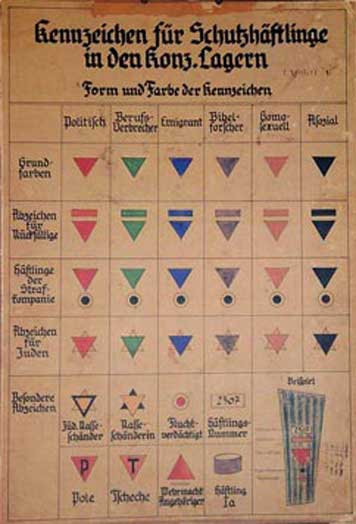
Chart of concentration camp badges worn in Dachau, c. 1936.
If the canard that Adolf Hitler was a superb art director is meant to glorify the art directorial profession, think again. Although historians say he was the "art dictator" of Germany because he spent an inordinate amount of time overseeing the art and design of the Third Reich, he nonetheless had thousands of willing "executioners," like Hugo Boss, designer and manufacturer of Wehrmacht and SS uniforms, doing the everyday work. Yet like art directors today, as Führer (leader) he received credit for everything under his domain, even those things he knew nothing about and had no hand in creating.
One such was the identification system implemented throughout the concentration camp network. No documentation has surfaced that proves Hitler had any direct input in developing the inverted triangle (known as the "Winkel") made of variously colored fabrics to distinguish homosexuals from habitual criminals from political enemies from Jehovah's Witnesses from Gypsies from, of course, Jews. But this color and symbol code (concentric circles distinguished failed escapees and were worn on prisoners' sleeves like boy scout merit badges) was initiated shortly after the Nazis opened the infamous Dachau in 1933, in a former munitions factory in Upper Bavaria. Although the camp was originally designed for the "protective custody" of political offenders, it soon swelled up with the regime's undesirables, most of who had to be segregated and then earmarked for "special treatment." It is probable that camp commandant Theodor Eicke was responsible for — or even the designer of — the classification scheme which, like the camp layout itself, became the model for all other camps in occupied Europe. (In fact, prospective camp commandants were required to complete a special "school of violence" at Dachau).
The inverted triangle was not based on the Nazi decree that all Jews wear a Yellow Star. The 1938 law that mandated this discriminatory marking did not really kick into common use around the Reich until 1941, although it was enforced in certain localities prior to that year. Still, prisoners were required to wear various markings, including a yellow right-side-up triangle behind the inverted one to indicate that he or she was, for instance, a "Jewish habitual criminal." So the Winkel prefigured (or inspired) the eventual branding of all Jews.
Neither Hitler nor the Nazis, however, invented the Yellow Star as the badge of humiliation. The concept of inequitable attire for Jews dated back to the ninth century A.D. when in the Middle East Jews were forced to wear a yellow belt and tall cone-like hat. In 1215 Pope Innocent III declared that non-emancipated "Jews and Saracens of both sexes in every Christian province and at all times shall be marked off in the eyes of the public from other peoples through the character of their dress." Other distinguishing labels or badges were instituted in Henry III's England and Louis IX's France. And in Austria Jews had to wear a horned hat that started out as a normal garment until declared exclusive to Jews.
The Star of David was often used in graphic art — cartoons, illustrations, etc. — to scold Jews, so it was no surprise that after the first boycott of Jewish businesses when the Nazis came to power in April 1933 stars were scrawled on storefronts and office buildings, an ironic twist on the Exodus tale of marking the doorposts with Lamb's blood to save the Jews from Plague. Yet it was only after the state-sponsored pogrom called Kristallnacht (the night of broken glass) in 1939 that deputy SS chief and architect of the Final Solution, Reinhard Heydrich, put forth the official sanction of wearing of the badge. After Poland was occupied and ghettos established, ordinances governing the wearing of the star were strictly enforced: "Today an order was announced that all Jews, no matter what age or sex, have to wear a band of 'Jewish-yellow,' 10 centimenters wide, on their right arm, just below the armpit," declared an official order. During the ensuing two years Yellow Stars with "Jude" in the middle set in Black Letter type were sold throughout Germany for mandatory use. Guidelines were also established about how and where the stars could be worn, and harsh punishment was meted out if they were creased, folded, or sloppily sewn.
The Yellow Star, like the concentration camp badges, served one overarching purpose — immediate, unequivocal identification. Rules were established for how the markings would be worn to insure the inmate's status was visible to guards and others, and to further distinguish Kapos (the brutal prisoner overseers drawn often from the criminal ranks) from the basic camp population. Charts showing the markings followed a distinct format, but were often hand made by "artist" inmates, who were also called upon to produce other discriminatory signs and placards for the camps.
The Winkel system was not the only standard design scheme produced in the camps. Prior to instituting the Final Solution, even Auschwitz, administered by the Reich Security Main Office (RSHA), produced currency, or Lagergeld, and stationery for prisoners' use. The former were usually small rectangular notes with a dubiously ironic text (like "work makes you free") and a colored triangle to indicate from which barrack or work battalion the user was from; latter was a self-contained mailer with a long list of restrictions from the commandant set perfectly in Black Letter.
Somewhere in the bowels of the Third Reich's bureaucracy a designer who belonged to the graphics "culture chamber," the representative, official body that sanctioned Nazi designers, produced the basic templates for these camp materials and then turned them over to skilled inmates to produce. Some prisoners used this opportunity to survive, but for most this only prolonged the inevitable.
Steven Heller is co-chair of SVA's MFA Designer as Author Program and editor of AIGA Voice. Heller is currently writing Iron Fists: Branding the Totalitarian State to be published by Phaidon Press in 2008. His website is hellerbooks.com.
